2025.02.24
- Features
-
Services/ProductsServices/ProductsServices/Products
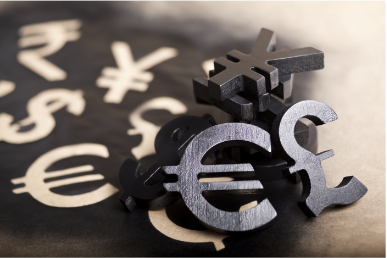
Learn more about the retail trading conditions, platforms, and products available for trading that FXON offers as a currency broker.
You can't start without it.
Trading Platforms Trading Platforms Trading Platforms
Features and functionality comparison of MetaTrader 4/5, and correspondence table of each function by OS
Two account types to choose
Trading Account Types Trading Account Types Trading Account Types
Introducing FXON's Standard and Elite accounts.
close close

-
SupportSupportSupport

Support information for customers, including how to open an account, how to use the trading tools, and a collection of QAs from the help desk.
Recommended for beginner!
Account Opening Account Opening Account Opening
Detailed explanation of everything from how to open a real account to the deposit process.
MetaTrader4/5 User Guide MetaTrader4/5 User Guide MetaTrader4/5 User Guide
The most detailed explanation of how to install and operate MetaTrader anywhere.
FAQ FAQ FAQ
Do you have a question? All the answers are here.
Coming Soon
Glossary Glossary GlossaryGlossary of terms related to trading and investing in general, including FX, virtual currencies and CFDs.
News News News
Company and License Company and License Company and License
Sitemap Sitemap Sitemap
Contact Us Contact Us Contact Us
General, personal information and privacy inquiries.
close close

- Promotion
- Trader's Market
- Partner
-
close close
Learn more about the retail trading conditions, platforms, and products available for trading that FXON offers as a currency broker.
You can't start without it.
Features and functionality comparison of MetaTrader 4/5, and correspondence table of each function by OS
Two account types to choose
Introducing FXON's Standard and Elite accounts.
Support information for customers, including how to open an account, how to use the trading tools, and a collection of QAs from the help desk.
Recommended for beginner!
Detailed explanation of everything from how to open a real account to the deposit process.
The most detailed explanation of how to install and operate MetaTrader anywhere.
Do you have a question? All the answers are here.
Coming Soon
Glossary of terms related to trading and investing in general, including FX, virtual currencies and CFDs.
General, personal information and privacy inquiries.
Useful information for trading and market information is posted here. You can also view trader-to-trader trading performance portfolios.
Find a trading buddy!
Share trading results among traders. Share operational results and trading methods.
- Legal Documents TOP
- Client Agreement
- Risk Disclosure and Warning Notice
- Order and Execution Policy
- Complaints Procedure Policy
- AML/CFT and KYC Policy
- Privacy Policy
- eKYC Usage Policy
- Cookies Policy
- Website Access and Usage Policy
- Introducer Agreement
- Business Partner Agreement
- VPS Service Terms and Condition

This article was :
published
updated
Weekly FX Market Review and Key Points for the Week Ahead
In the foreign exchange market for the week that ended on February 23rd, the yen strengthened against the dollar as the market increased expectations that the Bank of Japan (BOJ) would raise interest rates, helped by stronger-than-expected Japan's GDP.
Meanwhile, the U.S. started to discuss a ceasefire in the Russia-Ukraine conflict with Russia. However, the difference in perceptions between the U.S. and European countries on this issue spread uncertainty in Europe. As a result, traders took a risk-off stance and sold the dollar, weakening it against the euro.
February 17 (Mon)
The USDJPY started the weekly trading session in the lower 152 yen range. Later, the yen strengthened against the dollar as Japan's GDP exceeded market expectations. After a brief rebound, the pair fell to the lower 151 yen range.
The EURUSD hovered in the upper 1.04 range, while the GBPUSD touched 1.263.
February 18 (Tue)
The USDJPY rose to 152 yen after comments from Federal Reserve Board of Governors member Christopher Waller lowered expectations for a U.S. interest rate cut. Thereafter, the pair lacked direction and fluctuated within the upper 151 yen range.
The euro weakened against the dollar, and the EURUSD fell to the 1.044 range. The GBPUSD hovered around the 1.26 level.
February 19 (Wed)
Hajime Takata, a BOJ Policy Board member, insisted that he was somewhat in favor of a rate hike. However, as his comments were confirmed in line with market expectations, the yen weakened against the dollar.
After that, the increased dollar selling momentum pushed the USDJPY down to the middle of the 151 yen range. In addition, the minutes of the FOMC meeting revealed that the FRB will hold off on lowering interest rates for the time being. However, the market's reaction was limited.
Meanwhile, uncertainty is spreading in Europe as the U.S. and Russia began talks on a ceasefire for the Russia-Ukraine conflict and the U.S. and E.U. began trade talks. The EURUSD fell to the 1.04 range, and the GBPUSD also fell to the upper 1.25 range.
February 20 (Thu)
As the market increased expectations that the BOJ would raise interest rates, traders were more inclined to buy the yen. In addition, differences in perceptions regarding the development of the ceasefire between the U.S. and Europe also contributed to the dollar's weakness. The USDJPY broke below the 150 yen level and fell to 149.3 yen.
As the dollar weakened, the EURUSD rose to the 1.05 range and the GBPUSD climbed to the upper 1.26 range.
February 21 (Fri)
BOJ Governor Kazuo Ueda stated before the Lower House Budget Committee that the central bank would stand ready to ramp up its purchase of government bonds if long-term interest rates rose sharply. This statement increased the momentum of yen selling, and the USDJPY climbed to 150.7 yen in the afternoon of Tokyo time.
However, the pair fell back to the 148 yen range after the disappointing U.S. economic data. Growing expectations that the BOJ will raise interest rates soon, as well as traders' risk-off stance, also helped strengthen the yen.
The EURUSD fell to the upper 1.045 range, and the GBPUSD also fell to the lower 1.26 range.
Economic Indicators and Statements to Watch this Week
(All times are in GMT)
February 24 (Mon)
- 10:00 Europe: January Harmonised Index of Consumer Prices (revised HICP)
- 10:00 Europe: January Harmonised Index of Consumer Prices (revised HICP core index)
February 26 (Wed)
- 15:00 U.S.: January new home sales
February 27 (Thu)
- 12:30 Europe: European Central Bank (ECB) Governing Council meeting minutes
- 13:30 U.S.: October-December quarterly real gross domestic product (revised GDP)
February 28 (Fri)
- 13:30 U.S.: January personal consumption expenditures (PCE deflator)
- 13:30 U.S.: January personal consumption expenditures (PCE core deflator, excluding food and energy)
This Week's Forecast
The following currency pair charts are analyzed using an overlay of the ±1σ and ±2σ standard deviation Bollinger Bands, with a 20-period moving average.
USDJPY
Growing expectations of another BOJ rate hike will spur buying momentum for the yen, while risk-off traders will sell the dollar. Therefore, the yen is expected to continue strengthening against the dollar. The USDJPY may break below the key 150 yen level and continue to fall.
Next is an analysis of the USDJPY daily chart.
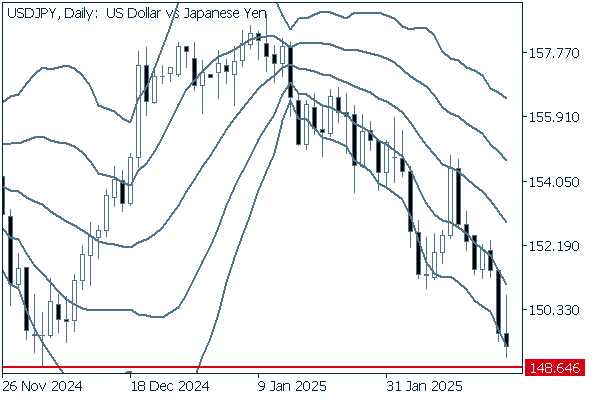

As the downtrend continues, the pair is now approaching the December 2024 monthly low of 148.64 yen. If it breaks below this level, the current downtrend is likely to accelerate.
We continue with an analysis of the USDJPY weekly chart.
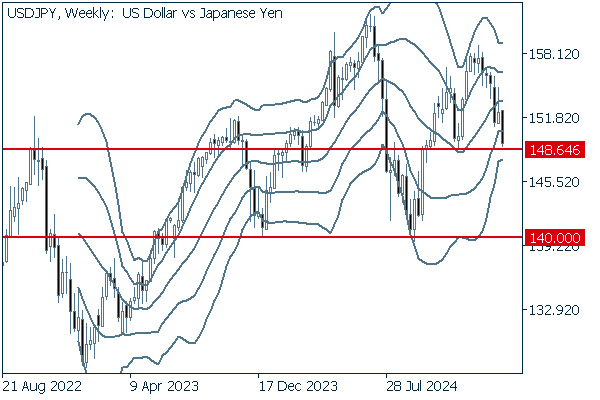

From a long-term perspective, the current downtrend has offset the gain that began in December 2024. If the pair breaks below the recent low of 148.64 yen, it could fall as low as 140 yen, the level it reached in September 2024. It is safe to say that the downtrend is likely to continue.
EURUSD
Amid concerns over the sluggish recovery of the European economy, it is necessary to carefully assess economic indicators such as the HICP. In addition, the ceasefire talks for the Russia-Ukraine conflict also bring uncertainty to Europe. There is a possibility that the momentum of euro selling may intensify.
Next is an analysis of the EURUSD daily chart.
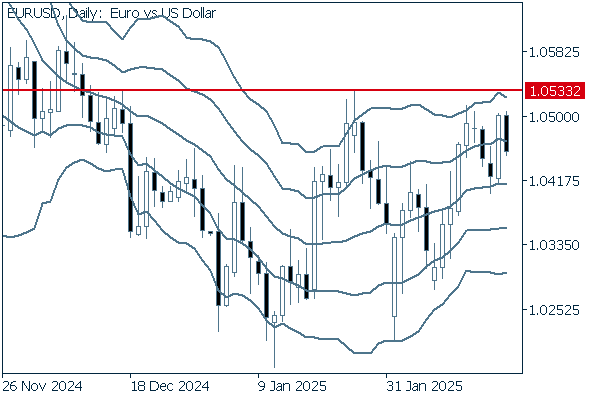

Last week, the pair hovered around +1σ as it failed to break above the 1.05 level. If it succeeds in breaking above 1.0533, the pair's current rally is likely to continue.
We continue with an analysis of the EURUSD weekly chart.
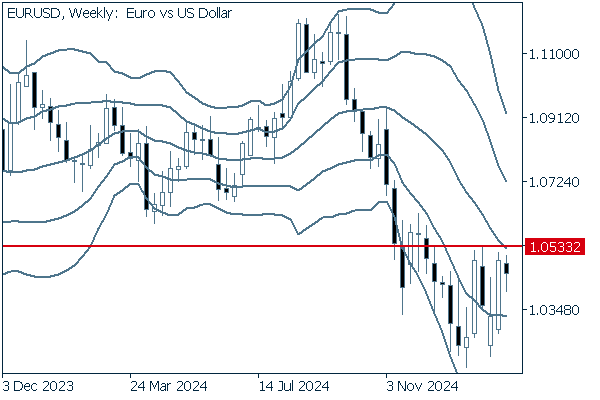

On the weekly chart, the pair has clearly broken above -1σ and is now just below the middle line. As with the daily chart, if the pair can break above 1.0533, the upper level of the current box-shaped range, it will be high time to consider that the current trend is clearly reversing to an upward direction.
GBPUSD
The GBPUSD has been performing well as sluggish U.S. economic data and traders' risk-off stance have contributed to the dollar's weakness. There are no major economic indicators from the U.K. this week. Therefore, it is important to keep a close eye on the dollar's behavior.
Now, we analyze the daily GBPUSD chart.
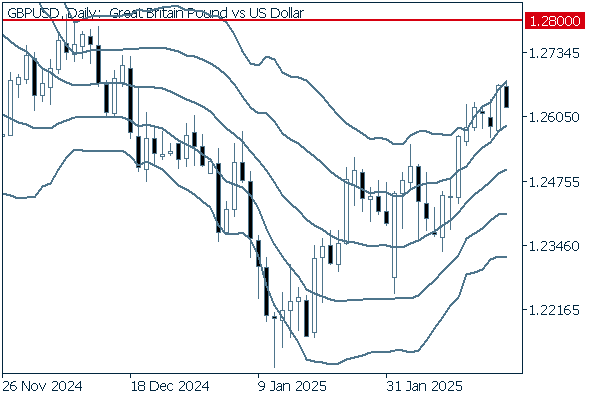

The GBPUSD has shown steadiness as the upward pair broke above the 1.26 level last week. Meanwhile, the daily chart indicates that the pair hovered between +1σ and +2σ last week. There is a possibility that the pair will fall after reaching +2σ. However, it is safe to assume that the uptrend will continue.
We continue with an analysis of the GBPUSD weekly chart.
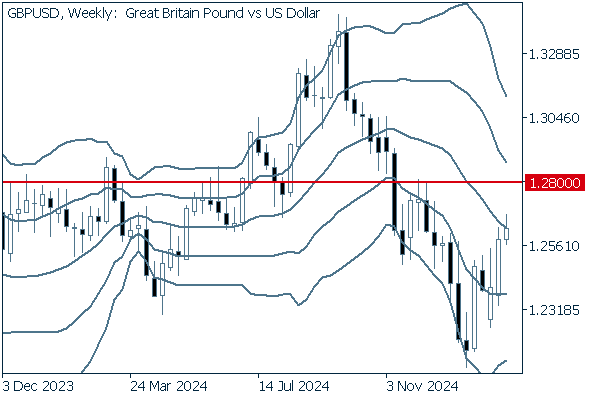

On the weekly chart, three consecutive positive candlesticks have appeared, and the pair reached the middle line last week. If the pair continues to rally towards 1.28, it is likely to return to last year's level. It is safe to assume that the uptrend will continue.
Was this article helpful?
0 out of 0 people found this article helpful.
Thank you for your feedback.
FXON uses cookies to enhance the functionality of the website and your experience on it. This website may also use cookies from third parties (advertisers, log analyzers, etc.) for the purpose of tracking your activities. Cookie Policy
